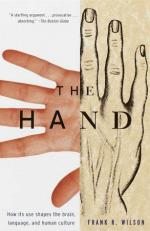
|
| Name: _________________________ | Period: ___________________ |
This test consists of 15 multiple choice questions and 5 short answer questions.
Multiple Choice Questions
1. How does the brain teach itself in order to juggle?
(a) By making the brain and hand work together.
(b) By learning how to trigger individual muscles rather than groups of muscles.
(c) By learning how to trigger groups of muscles rather than individual muscles.
(d) By requiring the juggler to repeat a motion over and over.
2. What operator has to do to anticipate load weight and wind changes?
(a) A crane operator.
(b) A grain elevator operator.
(c) An elevator operator.
(d) A bulldozer operator.
3. What is the hand considered in the metaphor in number 26?
(a) The balance beam.
(b) The beak.
(c) The block.
(d) The bucket.
4. How does a goat eat a piece of candy?
(a) The wrapper and the candy.
(b) Just the wrapper.
(c) Sometimes just the wrapper and sometimes just the candy.
(d) Just the candy.
5. What does the author say comes to life even before you rise out of bed in the morning?
(a) Your dog.
(b) Your brain.
(c) Hands and arms.
(d) Your digestive juices.
6. What does the hand "think" about as it helps you get ready for the day?
(a) How to grasp something without dropping it.
(b) How to move each muscle fgr each task.
(c) Nothing.
(d) How to movie each tendon and ligament for each task.
7. What does the neocortex size reliably predict?
(a) Group size.
(b) Intelligence.
(c) Evolution rate.
(d) Aggressiveness.
8. What sport does David participate in during High School?
(a) Basketball.
(b) Soccer.
(c) Tennis.
(d) Wrestling.
9. What does Herophilus discover?
(a) Neurons can regenerate.
(b) Some neurons connect muscles to the spinal cord; whereas, other connect muscles to bone.
(c) The muscles along the spinal cord are denser because of the neurons packed in them.
(d) Neurons cannot regenerate.
10. What supports the conscious dimension of action?
(a) The conscious intent to move.
(b) The unconscious interaction of the neuromuscular system.
(c) The unconscious image of movement.
(d) The brain.
11. How long can a grip on a rock last for a climber?
(a) It is incalculable.
(b) Several minutes.
(c) Forty seconds.
(d) Twenty seconds.
12. How many types of grips does Mary Marzke classify?
(a) 1.
(b) 10.
(c) 15.
(d) 3.
13. What is one thing the thumb is uniquely able to do?
(a) Hyperextend.
(b) Nothing.
(c) Bend at the middle knuckle.
(d) Move independently of any other finger.
14. What did hominids require in order to expand their range beyond the jungle?
(a) Opposing thumb.
(b) Brain evolution.
(c) Agriculture.
(d) Walking upright.
15. What is the hand's optimal position over the keyboard?
(a) With the palm slightly convex.
(b) With the fingers fairly rigid.
(c) A gentle curve.
(d) With the fingers spread as far as possible.
Short Answer Questions
1. Why is now known to be important that originally was not thought to be so during early studies?
2. How many muscles that are attached to the thumb enable it to do its work?
3. From what does the word neuron derive its meaning?
4. What is the other main reason the author writes this book on the hand?
5. How is the arm different from the leg in how it's attached to the body?
|
This section contains 574 words (approx. 2 pages at 300 words per page) |

|




